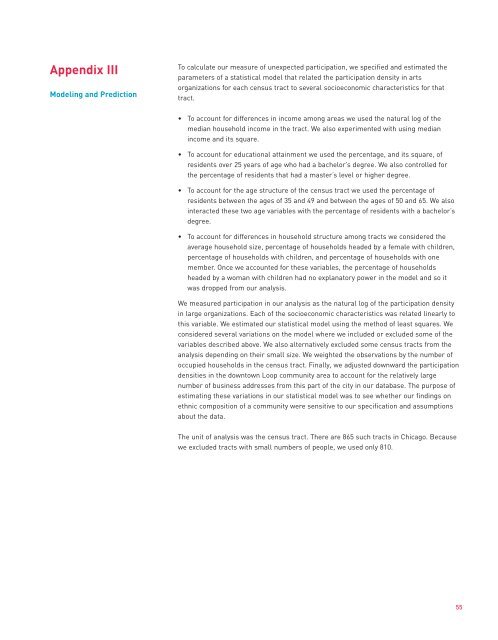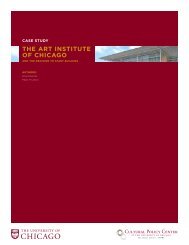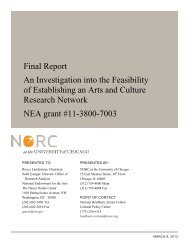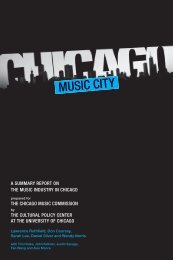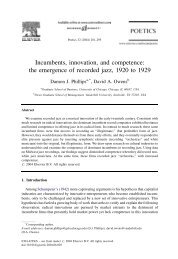Appendix IIIModel<strong>in</strong>g and PredictionTo calculate our measure of unexpected participation, we specified and estimated theparameters of a statistical model that related the participation density <strong>in</strong> artsorganizations for each census tract to several socioeconomic characteristics for thattract.• To account for differences <strong>in</strong> <strong>in</strong>come among areas we used the natural log of themedian household <strong>in</strong>come <strong>in</strong> the tract. We also experimented with us<strong>in</strong>g median<strong>in</strong>come and its square.• To account for educational atta<strong>in</strong>ment we used the percentage, and its square, ofresidents over 25 years of age who had a bachelor’s degree. We also controlled forthe percentage of residents that had a master’s level or higher degree.• To account for the age structure of the census tract we used the percentage ofresidents between the ages of 35 and 49 and between the ages of 50 and 65. We also<strong>in</strong>teracted these two age variables with the percentage of residents with a bachelor’sdegree.• To account for differences <strong>in</strong> household structure among tracts we considered theaverage household size, percentage of households headed by a female with children,percentage of households with children, and percentage of households with onemember. Once we accounted for these variables, the percentage of householdsheaded by a woman with children had no explanatory power <strong>in</strong> the model and so itwas dropped from our analysis.We measured participation <strong>in</strong> our analysis as the natural log of the participation density<strong>in</strong> large organizations. Each of the socioeconomic characteristics was related l<strong>in</strong>early tothis variable. We estimated our statistical model us<strong>in</strong>g the method of least squares. Weconsidered several variations on the model where we <strong>in</strong>cluded or excluded some of thevariables described above. We also alternatively excluded some census tracts from theanalysis depend<strong>in</strong>g on their small size. We weighted the observations by the number ofoccupied households <strong>in</strong> the census tract. F<strong>in</strong>ally, we adjusted downward the participationdensities <strong>in</strong> the downtown Loop community area to account for the relatively largenumber of bus<strong>in</strong>ess addresses from this part of the city <strong>in</strong> our database. The purpose ofestimat<strong>in</strong>g these variations <strong>in</strong> our statistical model was to see whether our f<strong>in</strong>d<strong>in</strong>gs onethnic composition of a community were sensitive to our specification and assumptionsabout the data.The unit of analysis was the census tract. There are 865 such tracts <strong>in</strong> <strong>Chicago</strong>. Becausewe excluded tracts with small numbers of people, we used only 810.55
Appendix IVGlossaryArts participation/audience participation:Individuals who have through an action, or aseries of actions, engaged themselves withone or more of the partner<strong>in</strong>g organizations,result<strong>in</strong>g <strong>in</strong> their name and address be<strong>in</strong>g<strong>in</strong>cluded on a mail<strong>in</strong>g list.Census tracts: The U.S. Census Bureaudef<strong>in</strong>es census tracts to be small, relativelypermanent statistical subdivisions of acounty. They are relatively compact,cont<strong>in</strong>uous land areas. Tract boundariesnormally follow visible features, such asroads, but may follow governmental unitboundaries. They are <strong>in</strong>tended to berelatively homogeneous units with respectto population characteristics, economicstatus, and liv<strong>in</strong>g conditions. Census tractsaverage about 4,000 <strong>in</strong>habitants. (Source:U.S. Census Bureau website)<strong>Chicago</strong> metropolitan statistical area(CMSA): the fourteen-county area that<strong>in</strong>cludes Cook, DeKalb, DuPage, Grundy,Kane, Kendall, Lake, McHenry, and WillCounties <strong>in</strong> Ill<strong>in</strong>ois; Kenosha County <strong>in</strong>Wiscons<strong>in</strong>; and Jasper, Lake, Newton, andPorter Counties <strong>in</strong> Indiana.Community: def<strong>in</strong>ed as either a censustract, which typically consists of approximately4,000 residents; a community area<strong>in</strong> the City of <strong>Chicago</strong>; or a township <strong>in</strong> thesurround<strong>in</strong>g suburbs.Community areas: districts that weredel<strong>in</strong>eated <strong>in</strong> the 1920s to identify areas witha dist<strong>in</strong>ct history and community awareness.Data: records of the study’s partner<strong>in</strong>garts and culture <strong>in</strong>stitutions. Each data po<strong>in</strong>tis an adm<strong>in</strong>istrative record of a transactionbetween the <strong>in</strong>stitution and an <strong>in</strong>dividual orhousehold.Density of participation: a measure of theproportion of households <strong>in</strong> a communitythat participate <strong>in</strong> an arts organization ororganizations. It is def<strong>in</strong>ed as the ratio ofthe number of households that appear <strong>in</strong>the databases of these organizations dividedby the total number of households <strong>in</strong> thecommunity.Diverse <strong>in</strong>stitutions: organizations whosemission statements explicitly identify theirpurpose as represent<strong>in</strong>g and/or target<strong>in</strong>gmultiple ethnic or cultural groups.Educational atta<strong>in</strong>ment: refers to thepercentage of adults <strong>in</strong> an area who are25 or older who have a bachelor’s degree orhigher.Ethnically/culturally specific <strong>in</strong>stitutions:organizations whose mission statementsexplicitly identify their purpose as represent<strong>in</strong>gand/or target<strong>in</strong>g a particular ethnicor cultural group.Household: <strong>in</strong>cludes all the persons whooccupy a hous<strong>in</strong>g unit. A hous<strong>in</strong>g unit is ahouse, an apartment, a mobile home, agroup of rooms, or a s<strong>in</strong>gle room that isoccupied (or if vacant, is <strong>in</strong>tended foroccupancy) as separate liv<strong>in</strong>g quarters.The occupants may be a s<strong>in</strong>gle family, oneperson liv<strong>in</strong>g alone, two or more familiesliv<strong>in</strong>g together, or any other group of relatedor unrelated persons who share liv<strong>in</strong>garrangements. (Source: U.S. Census Bureauwebsite)Larger <strong>in</strong>stitutions: arts and culture<strong>in</strong>stitutions whose total revenue exceeds$8 million.Median household <strong>in</strong>come: an approximatemeasure of the household <strong>in</strong>come of thetypical household <strong>in</strong> an area. It divides thehousehold <strong>in</strong>come distribution <strong>in</strong>to twoequal parts: one-half of the cases fall belowthe median household <strong>in</strong>come, and onehalfabove it. (Source: U.S. Census Bureauwebsite)Mid-size and small <strong>in</strong>stitutions: arts andculture <strong>in</strong>stitutions whose total revenue isunder $8 million.Nonrespondents: those arts and cultureorganizations that did not participate <strong>in</strong>the study.Partner<strong>in</strong>g organizations: those arts andcultural organizations that participated <strong>in</strong>the study by submitt<strong>in</strong>g their mail<strong>in</strong>g lists.56


